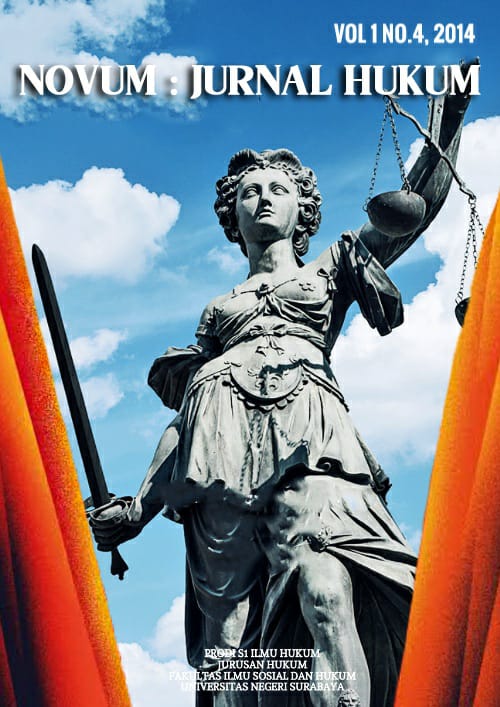PERLINDUNGAN HUKUM TERHADAP KREDITUR DALAM PEMENUHAN PIUTANG YANG DIMILIKI (Studi Kasus Putusan Mahkamah Agung No. 2357K/Pdt/2010)
Abstract
Utang piutang menimbulkan resiko adanya wanprestasi. Wanprestasi terjadi jika kedua belah pihak atau salah satu pihak tidak melaksanakan kewajibannya. Wanprestasi oleh debitur menjadikan tidak kembalinya piutang kreditur. Saat debitur wanprestasi, harta debitur tersebut dijadikan pelunasan utang. Kreditur dapat mengajukan permohonan kepada hakim untuk mendapat pelunasan utang. Namun kreditur tidak mendapat pelunasan piutang dari debitur karena ketika proses di Pengadilan benda yang dimohonkan sita jaminan ternyata dieksekusi oleh kreditur preference. Selain itu Mahkamah Agung menganggap hubungan hukum antara debitur dan kreditur tidak jelas karena perjanjian utang piutang yang dibuat hanya perjanjian utang piutang di bawah tangan bukan dalam bentuk Akta Notaris. Penelitian ini bertujuan untuk mengetahui tentang perlindungan hukum bagi seorang kreditur dan untuk mengetahui tentang upaya hukum yang dapat dilakukan oleh kreditur dalam menuntut pemenuhan hak. Metode penelitian ini adalah yuridis normatif. Penelitian ini membutuhkan dua jenis bahan hukum, yakni bahan hukum primer yang terdiri dari berbagai peraturan perundang-undangan dan bahan hukum sekunder yang terdiri atas buku-buku dan informasi dari internet yang berkaitan dengan isu hukum yang dibahas. Dalam menganalisis hasil penelitian, peneliti menggunakan tiga pendekatan yakni pendekatan perundang-undangan pendekatan konseptual dan pendekatan kasus. Hasil penelitian menunjukkan bahwa hukum telah memberikan perlindungan terhadap kreditur yang diatur dalam pasal 1131 KUH Perdata, serta asas schuld dan haftung yang juga mengatur tentang tanggung jawab pihak debitur terhadap semua utangnya, tanggung jawab tersebut berupa pelunasan utang oleh debitur dengan cara menyediakan hartanya sebagai jaminan pelunasan utang. Penyelesaian sengketa secara litigasi menunjukkan bahwa piutang kreditur tidak dapat kembali, karena kreditur merupakan kreditur konkuren sedangkan objek jaminan yang dimohonkan sita telah dijaminkan kepada kreditur sebelumnya. Kreditur dapat menempuh upaya peninjauan kembali jika dapat memenuhi alasan peninjauan kembali yang diatur dalam pasal 67 undang-undang No.14 tahun 1985 tentang Mahkamah Agung. Apabila tidak dimungkinkan untuk mengajukan peninjauan kembali, maka kreditur dapat menempuh upaya mengajukan gugatan baru dengan objek tuntutan yang berbeda. Meskipun dengan para pihak dan alasan tuntutan yang sama gugatan baru dapat dilakukan asal tidak memenuhi syarat asas ne bis in idem yang ditentukan dapam pasal 1917 KUH Perdata.
Kata Kunci : Pemenuhan Piutang Kreditur, Jaminan.
Abstract
Debts raises the risk of default. Default may occur if both sides or one side does not perform its obligations. Debtor default will make refund cannot be repaid. When the debtor defaults, the debtor's property used as a debt repayment. Creditors can apply to the magistrate to get the debt repayment. However, the creditors do not get the debt repayment from the debtor because when the objects are filed in court, foreclosure turns executed by the preference creditors. Beside that, Supreme Court considers that the legal relationship between the debtor and the creditor is incomprehensible because of the debt agreement made just debt receivable under the loan agreement and do not from hands of the notary deed. This study aims to find out about the legal protection of a creditor and to find out about the legal remedies for creditor repayment.This research method is normative juridical. This research requires three types of legal materials, which the primary legal materials consisting of various legislation and secondary law materials consisting of books and information from the internet relating to legal issues are discussed. In analyzing research, researcher used three approaches namely statutory approach (statute approach), conceptual approach and case approach. The results showed that the Law has provided protection against creditors provided for in article 1131 of the Civil Code, as well as the principle of Schuld and haftung which also regulates the responsibility of the debtor for all debts, liability in the form of repayment of the debt by the debtor by way of providing his property as collateral for repayment debt. Litigation dispute resolution shows that the creditor refund cannot repaid , because creditors are unsecured creditors filed bail while the object has pledged to creditors seized earlier. The creditors can take the request civil if it statisfies the request civil reasons set out in article 67 of law supreme sourt. If it is not possible to apply for request civil, the creditor can filed a new lawsuit with different demands objects. Although, with the parties and the same reason that a new lawsuit claims do not meet the requirements of origin ne bis in idem principle the article 1917 of the civil code.
Keywords : Creditor Repayment, Guarantee.

